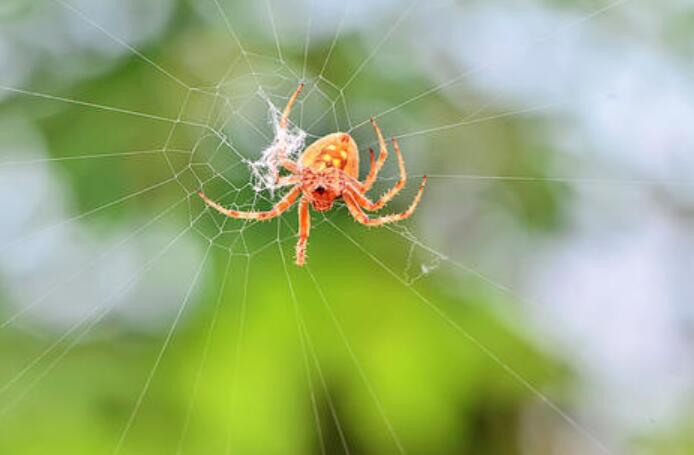The reason why spiders can weave webs
Whether indoors or outdoors, it is not difficult for us to find spider webs. Each web is woven with very thin silk threads. These webs can be used to catch flies, mosquitoes, beetles or other insects. The caught insects become spider food. How do spiders make webs? Spiders are arthropods that spin silk.
The wires of the net are so thin that it is difficult to see clearly. If you observe with a magnifying glass, you can see clearly. The silk that weaves the web comes from the kid L on the tail of the spider. Scientists call this kid L a silk sac. The silk thread is secreted by the textile glands in the spider’s body. This liquid becomes hard when it comes out of the spider’s body and encounters air.
Sometimes the spider needs the help of its hind limbs to draw out the silk. The spider spit out silk to make a web on the grass, among the branches or under the eaves. After weaving the web, it forms a silk nest near the web; then, the spider hides in the nest, waiting to catch what fell in the web. Bug. Although spider silk is very thin, it is actually very strong. It can stretch like a rubber band. When a small worm falls in the web, the web will lengthen, but it will not crush the web.
High winds can blow leaves and dust on the web, but they cannot break the web. If the web is broken, the spider will be careful and quickly repair the web. In addition to preying on small insects with silk webs, spiders also use silk threads to protect themselves.
When you bounce the spider off the tree, the spider will not fall to the ground. It will spin silk and hang its body slowly and fall to the ground, or hang on the silk thread to swing back and forth, and then slowly crawl back along the silk thread. On the branch. Why do small insects eaten by spiders leave empty shells in summer? It is very interesting to observe spiders preying on insects. When flies or mosquitoes are used to woven with very thin silk thread. These webs can be used to catch flies, mosquitoes, beetles or other insects. The caught insects become spider food. How do spiders make webs? Spiders are arthropods that spin silk.
The wires of the net are so thin that it is difficult to see clearly. If you observe with a magnifying glass, you can see clearly. The silk that weaves the web comes from the kid L on the tail of the spider. Scientists call this kid L a silk sac. The silk thread is secreted by the textile glands in the spider’s body. This liquid becomes hard when it comes out of the spider’s body and encounters air.
Sometimes the spider needs the help of its hind limbs to draw out the silk. The spider spit out silk to make a web on the grass, among the branches or under the eaves. After weaving the web, it forms a silk nest near the web; then, the spider hides in the nest, waiting to catch what fell in the web. Bug. Although spider silk is very thin, it is actually very strong. It can stretch like a rubber band. When a small worm falls in the web, the web will lengthen, but it will not crush the web. High winds can blow leaves and dust on the web, but they cannot break the web. If the web is broken, the spider will be careful and quickly repair the web.
In addition to preying on small insects with silk webs, spiders also use silk threads to protect themselves. When you bounce the spider off the tree, the spider will not fall to the ground. It will spin silk and hang its body slowly and fall to the ground, or hang on the silk thread to swing back and forth, and then slowly crawl back along the silk thread. On the branch. Why do small insects eaten by spiders leave empty shells in summer? It is very interesting to observe spiders preying on insects. When small bugs such as flies or mosquitoes hit the spider web, the spider hiding in the corner of the web will quickly crawl over and pull out a long silk from the tail, tightly entwining the struggling prey.
Looking back later, the spider seems to have had a full meal, but there is still a small insect shell on the spider web. It turns out that spiders have a special way of eating. The spider’s body also has a head, chest and abdomen (but it is not an insect). The abdomen is round, with a thin waist that meets the head and chest. In the cephalothorax, there is an esophagus that communicates with the stomach.
There are six pairs of attached limbs, two pairs at the front end. The first pair is called pincer horns, which can produce venom to poison insects; the second pair is called foot whiskers, which can assist in ingesting food. The four pairs behind are crawling steps. The spider’s mouth grows between the whiskers, the mouth is small, and it has no teeth for chewing food. Therefore, when small insects like flies and mosquitoes hit the spider web, the spider poisons the prey with the venom in the horns, wraps it around with spider silk, and spit out a digestive juice called enzyme, which is injected Inside the prey’s body. This digestive juice can dissolve protein, dilute the five internal organs, turn internal tissues into juice, and then suck into the stomach from a small mouth to fill the stomach.
In vitro digestion methods like spiders are rare in animals. Since the spider’s digestive juice cannot dissolve the shell of the small insect, after the spider has a full meal, the empty shell of the small insect, like an empty tin box, is completely discarded on the spider web.
The reason why spiders form webs
The most important feature of a web-forming spider is its web-forming behavior. Spiders secrete mucus through the protrusions at the tips of the silk sacs, which can condense into very thin silks when exposed to air. The web made of silk is highly sticky and is the main predation method of spiders. For insects that stick to the Internet, the spider will first inject a special liquid jujube digestive enzyme into the prey. This digestive enzyme can make insects coma, convulse, and die, and liquefy the body. After liquefaction, spiders eat by sucking. Spiders are oviparous. After mating with female spiders, most male spiders will be swallowed by female spiders and become food for female spiders. Wandering spiders do not form webs, but walk around or camouflage on the spot to prey on prey, such as tall spiders.
Types of spider webs
Piece of net
The most common is the web of a funnel spider, which includes a tubular shelter from which a dense horizontal web extends. The role of the web is not limited to transmitting information about the proximity of the prey, it can also delay the movement of the prey, so that the spider has more time to catch it. There are many funnel spiders entangled with many irregular filaments above the web, so as to better transmit vibration and intercept insects.
Round net
Round webs are found in the Arachnidae, Arachnidae and some related families. A round spider knots a typical round web. The round net of the spider knot is a horizontal round net with some silk threads added.
Other mesh
Fanwu spider’s web is triangular, only equivalent to a sector of the circular web. The Longwu spider is simpler, and the entire web consists of only one or a few sticky filaments. The demon-faced spider forms a small rectangular web. Instead of passively waiting for insects to hit the web, it uses two pairs of forefoot to pull the web. It actively catches insects like a dip net. Also like a meteor spider, it only uses 1 wire. A sticky ball with a volatile substance, which is similar to sex pheromone, the spider uses the forefoot to manipulate the silk like a hydrangea meteor, throwing the sticky ball at the end of the silk to its prey.






